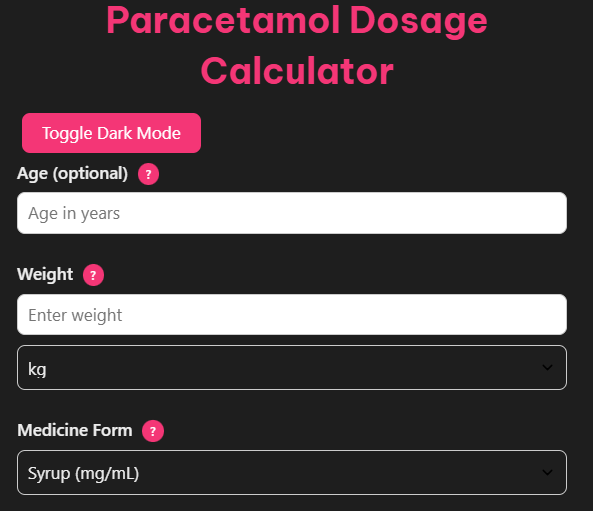Paracetamol Dosage Calculator
Results:
Estimated Weight: -
Minimum Dose: -
Maximum Dose: -
Volume or Unit: -
Dosing Interval: Every 4–6 hours
Max Doses: 4 in 24 hours
When it comes to managing fever or pain in children, accurate paracetamol dosing is critical. This ensures effective relief while avoiding potentially harmful overdosing or underdosing. However, calculating the right dosage can overwhelm even the most experienced caregivers. That’s where our Free Paracetamol Dosage Calculator comes in as a reliable, easy-to-use tool.
Designed for parents, caregivers, and even healthcare professionals, this tool simplifies the precise dosing process, offering confidence and peace of mind in moments of stress.
What Is Paracetamol?
Paracetamol, also known as acetaminophen, is one of the most commonly used medications for reducing fever and easing pain in both children and adults.
How Does It Work?
Paracetamol works by blocking the production of prostaglandins in the brain, chemicals responsible for causing fever and pain. Though it does not have anti-inflammatory properties like ibuprofen, paracetamol is often preferred because it is gentler on the stomach.
When Should You Use Paracetamol?
Paracetamol is commonly used for treating mild-to-moderate pain caused by teething, earaches, colds, or injuries. It is also effective in reducing fever without adverse effects when used correctly.
However, always consult a healthcare provider if the child’s symptoms persist or worsen despite using paracetamol.
Why Accurate Dosage Matters
Risks of Underdosing or Overdosing
- Underdosing may lead to inadequate pain or fever relief.
- Overdosing can result in severe liver damage, particularly in children. This makes precise dosing not just important but essential.
Factors Influencing Dosage
- Weight vs. Age
Paracetamol dosing is primarily based on a child’s weight rather than age to ensure maximum effectiveness and safety.
Introducing Our Free Paracetamol Dosage Calculator 2025

Our Paracetamol Dosage Calculator is an advanced, user-friendly tool tailored to simplify dosing decisions.
Features of the Calculator
- Weight-Based Calculation: Calculates dosage based on body weight (mg/kg), ensuring precision.
- Age Suitability: Designed for children aged 1 month to 18 years.
- Multiple Formats: Provides dosage calculations for both syrups and tablets.
- Safety Alerts: Displays maximum single and daily doses to prevent errors.
- Data Privacy: Does not collect or store personal information, offering complete privacy.
- User-Friendly Interface: Easy input fields for hassle-free usage.
- Professional Guidance: Clear reminders to consult pharmacists or healthcare providers if in doubt.
Who Can Use the Calculator?
This tool is perfect for parents and caregivers juggling busy routines and even healthcare professionals seeking quick, on-the-spot dosage guidance.
How to Use the Paracetamol Dosage Calculator
Step 1 Input Your Child’s Weight
Enter your child’s weight in kilograms into the calculator.
Step 2 Select Medication Type
Pick the form of paracetamol you have (syrup, tablet, or suppository) and the strength (e.g., 120mg/5ml or 250mg/5ml).
Step 3 Get Results
The calculator will provide the precise amount of medication in milligrams and suggest the proper measurement in teaspoons or milliliters for syrups.
Step 4 Administer the Dose
Double-check the measurement and administer the dosage using a syringe or proper measuring spoon.
General Dosage Guidelines
- Single Dose: Typically 15mg/kg per dose.
- Maximum Single Dose: Not to exceed 1g for older children.
- Frequency: Administer every 4–6 hours as needed.
- Maximum Daily Dose: Do not exceed four doses or 4g in 24 hours.
- When to Seek Professional Advice: Consult a healthcare provider if there are persistent symptoms, signs of dehydration, or new symptoms such as rashes or seizures.
Special Considerations
While the calculator is incredibly useful, some cases require extra caution.
- Infants Under 1 Month: Use only under medical supervision due to immature liver functions.
- Liver or Kidney Problems: Always consult a doctor before giving paracetamol.
- Drug Interactions: Be cautious if your child is already on other medications. Discuss with a pharmacist to avoid harmful interactions.
Real-Life Examples for Clarity
Example 1 Infant with Fever
A 6-month-old weighing 7kg requires fever management.
- Dose: 15mg/kg x 7kg = 105mg.
- If using syrup (120mg/5ml): (5ml / 120mg) x 105mg = 4.4ml.
Example 2 Toddler Recovering from Injury
A 2-year-old weighing 12kg needs pain relief.
- Dose: 15mg/kg x 12kg = 180mg.
- If using syrup (120mg/5ml): (5ml / 120mg) x 180mg = 7.5ml.
Example 3 Older Child with Headache
An 11-year-old weighing 40kg requires a dose nearing adult guidelines.
- Dose: 15mg/kg x 40kg = 600mg.
- Using a 500mg tablet: Slightly more than one tablet may be needed, but confirm with a pharmacist.
Measuring Liquid Medicines Accurately
- Syringe: Offers precise, easy-to-read measurements, suitable for small dosages.
- Measuring Spoon: Use a spoon specifically designed for medication, not a household spoon.
- Check Concentration: Always verify the medication’s concentration to ensure accurate dosing.
Safety and Precautions
- Always verify calculations before administering medication.
- Never exceed the maximum stated dose thresholds.
- If symptoms persist or worsen, seek medical attention immediately.
Actionable Next Steps Calculate Dosage with Confidence
Our Dosage Calculator eliminates guesswork, ensuring your child receives the right care without the risk of errors.
Start using the calculator today to make an informed, safe decision every time.